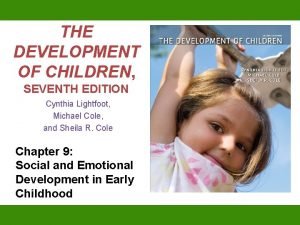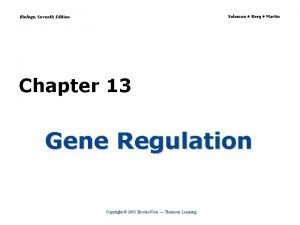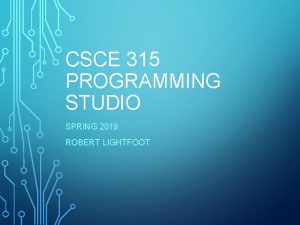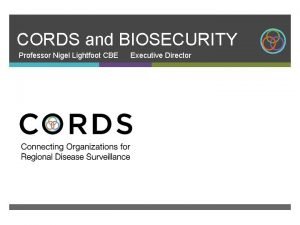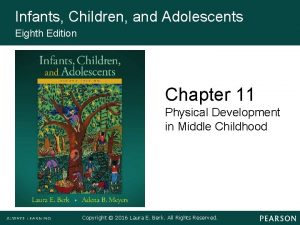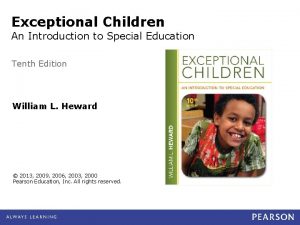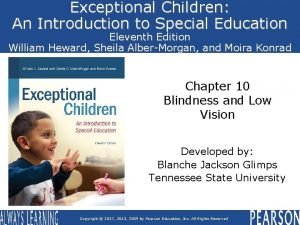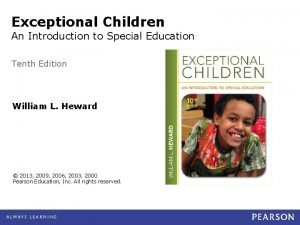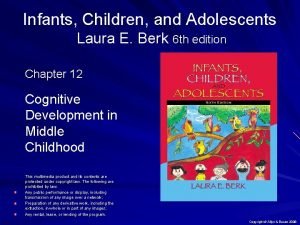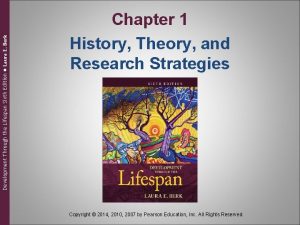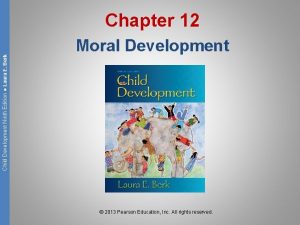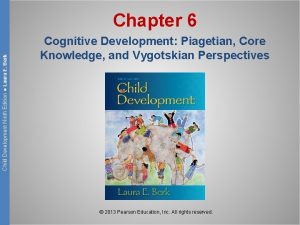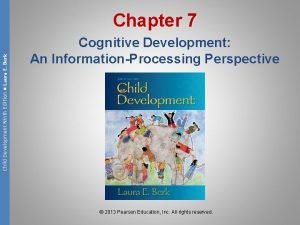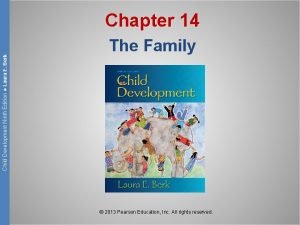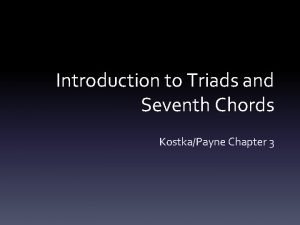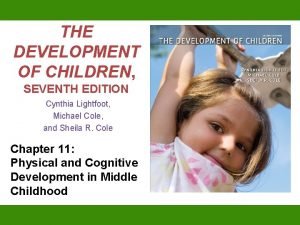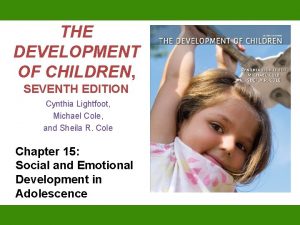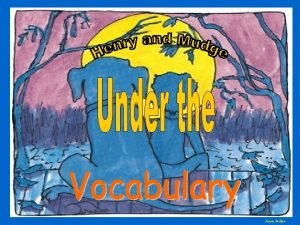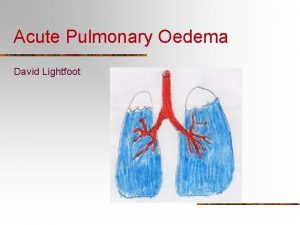THE DEVELOPMENT OF CHILDREN SEVENTH EDITION Cynthia Lightfoot










































- Slides: 42

THE DEVELOPMENT OF CHILDREN, SEVENTH EDITION Cynthia Lightfoot, Michael Cole, and Sheila R. Cole Chapter 9: Social and Emotional Development in Early Childhood

Chapter Overview I. Identity Development II. A New Moral World III. Developing Self-Regulation IV. Understanding Aggression V. Developing Prosocial Behaviors VI. Taking One’s Place in the Social Group

Social and Emotional Development • Two Paths: 1. Socialization 2. Personality Formation

Social and Emotional Development • Socialization: The process by which children acquire the standards, values, and knowledge of their society. • Personality Formation: The process through which children develop their own unique patterns of feeling, thinking, and behaving in a wide variety of situations.

I. Identity Development • Identification: A psychological process in which children try to look, act, feel, and be like significant people in their social environment. • Includes acquisition of sex-role and ethnic identities

Sex-Role Identity • • • Psychodynamic View Social Learning View Cognitive-Development View Gender Schema View Cultural View

Psychodynamic View • Sigmund Freud – Still influential, even though not always substantiated by evidence – Assumes young children are caught in hidden conflicts between their fears and desires.

Psychodynamic View • Phallic Stage: The period around the fourth year when children begin to regard their own genitals as a major source of pleasure.

Phallic Stage • Mental conflicts with same-sex parent – Oedipus complex – Electra complex

Social Learning View • Emphasizes two processes: – Modeling • The process by which children observe and imitate individuals of their own sex. – Differential Reinforcement • The process by which girls and boys are differently rewarded for engaging in genderappropriate behavior.

Cognitive-Development View • Central Idea: – A child’s own conceptions are central to the formation of sex-role identity. • Jean Piaget • Lawrence Kohlberg – Three Stages

Kohlberg’s Three Stages 1. Basic Sex-Role Identity: - Labeling oneself as a boy or girl 2. Sex-Role Stability: - Understanding the stability of sex roles over time 3. Sex-Role Constancy: - Understanding their sex remains the same no matter what the situation

Gender Schema View • Includes features of both social learning and cognitive-developmental theories. • Gender Schema: A mental model containing with information about males and females that are used to process gender-relevant information.

How Gender Schemas Work

Cultural View • Cultural gender categories mediate – Children’s organization of activities – Way children relate to environment • Methods of mediation – Content • Which behaviors specifically male or female – Extent of rigidness of gender categories

Ethnic Identity • Ethnic identity: A sense of belonging to an ethnic group, and the feelings and attitudes that accompany the sense of group membership. • Parents can communicate different sorts of ethnicity-related messages

Personal Identity • Personal identity: – I-self: A person’s subjective sense of being a particular individual who exists over time and who acts and experiences the world in a particular way – Me-self: A person’s sense of his or her objective characteristics such as appearance and abilities that can be objectively known

Personal Identity • Cognitive limitations in young children: – Focus on the objective self – Disconnected – Unrealistically positive – Fluid and disjointed

I. Apply – Connect – Discuss • Visit a major toy store and look for evidence of social categories of gender and ethnicity. • What sorts of toys are marketed for boys, girls, or children of specific ethnic backgrounds? • How might these toys mediate children’s behavior?

Apply – Connect – Discuss • Visit the children’s section of a public library and look for similar evidence of social categories in books appropriate for 3 - to 5 -year-olds (you might enlist the help of the librarian). • What similarities and differences do you note between books and toys?

II. A New Moral World • Three perspectives – Psychodynamic View – Cognitive-Development View – Social Domain View

Psychodynamic View • Sigmund Freud • Source of moral sense: – Internalization of the moral standards of our parents (especially same-sex parent) • Personality Mental Structure – Id – Ego – Superego

Cognitive-Development View • Jean Piaget • Heteronomous morality – Early childhood – External authority – Objective consequences • In middle childhood: – Autonomous morality • Freely chosen morals

Social Domain View • Emphasizes different type of right and wrong • Social domain theory – Moral rules – Social conventions – Personal sphere rules • Cultural variations

II. Apply – Connect – Discuss • Erikson believed that identity development and moral development are closely related. • Using material presented in this chapter, pull together evidence for his argument.

III. Developing Self-Regulation • Self-Regulation: The ability to control one’s thoughts, behaviors, and emotions.

Self-Regulation and Play • Importance of play – Vygotsky – Sociodramatic play

Regulating Emotions • Controlling feelings • Controlling and understanding emotion expressions • The influence of culture

III. Apply – Connect – Discuss • We argued in Chapter 6 that one of the earliest purposes of emotion regulation was to maintain intersubjectivity. • Review pages 205 -209 and discuss the similarities and differences between infancy and early childhood in the purposes and consequences of emotion regulation.

IV. Understanding Aggression • Two main categories of aggression: – Hostile aggression: • intended to hurt someone in some way – Instrumental aggression: • intended to achieve a particular goal

Forms of Aggression • Physical aggression • Teasing – By age 2, more likely to tease siblings than hurt them physically • Relational aggression

Gender Differences • Boys: – More often use direct, physical aggression • Girls – Use more relational aggression: • Indirect aggression aimed at excluding a child or harming their friendships

Causes of Aggression • Biological contributions • Social and cultural contributions • Emotional and cognitive contributions

Biological Contributions • Evolutionary Factors – Competition for resources – Development of dominance hierarchies • Physiological Factors – Testosterone

Social and Cultural Contribution • Imitation of others – Rewarded for behaving aggressively – Influence of parents • Cross-cultural studies – The work of Douglas Fry

Emotional and Cognitive Contribution • Focus more on how children think and feel • Emotional reactions to events and emotion regulation depend on: – Interpretation of the social context – Ability to understand others’ emotions and intentions

IV. Apply – Connect – Discuss • Based on evidence presented in this section, design an activity for preschoolers that might reduce their aggressive behavior.

V. Developing Prosocial Behaviors • Prosocial Behavior: Voluntary actions intended to benefit others, such as sharing, helping, caregiving, and showing compassion.

Empathy • Empathy: The sharing of another person’s emotions and feelings. • Relationship to egocentrism

Sympathy • Sympathy: Feelings of sorrow or concern for another. • More likely to lead to prosocial behavior • Personal Distress: A self-focused emotional reaction to another person’s distress.

V. Apply – Connect – Discuss • From a Vygotskian perspective, what might account for whether children react to someone’s distress with their own personal distress or with sympathy?

VI. Taking One’s Place in the Social Group • Increasing abilities: – understanding others’ mental states – regulating social relations – individual ways of thinking and feeling
 Critical period vs sensitive period
Critical period vs sensitive period The development of children 7th edition
The development of children 7th edition Human anatomy and physiology seventh edition marieb
Human anatomy and physiology seventh edition marieb Database system concepts seventh edition
Database system concepts seventh edition Principles of information system
Principles of information system Molecular biology of the cell seventh edition
Molecular biology of the cell seventh edition Biology seventh edition
Biology seventh edition Guy lightfoot
Guy lightfoot Guy lightfoot
Guy lightfoot Robert lightfoot tamu
Robert lightfoot tamu Joshua lightfoot
Joshua lightfoot Nigel lightfoot
Nigel lightfoot Gains in perspective taking permit the transition to
Gains in perspective taking permit the transition to Infants, children and adolescents 8th edition
Infants, children and adolescents 8th edition Exceptional children 10th edition
Exceptional children 10th edition Introduction of exceptional child
Introduction of exceptional child Exceptional children 10th edition
Exceptional children 10th edition Infants, children, and adolescents 8th edition
Infants, children, and adolescents 8th edition Infants and children 8th edition
Infants and children 8th edition Using mis (10th edition) 10th edition
Using mis (10th edition) 10th edition Chapter 1
Chapter 1 Unit 18 assessing children's development support needs p1
Unit 18 assessing children's development support needs p1 Week by week plans for documenting children's development
Week by week plans for documenting children's development Development through the lifespan 6th edition
Development through the lifespan 6th edition Laura e berk child development 9th edition pdf
Laura e berk child development 9th edition pdf Child development berk 9th edition
Child development berk 9th edition Child development: an active learning approach 4th edition
Child development: an active learning approach 4th edition Child development laura berk 9th edition
Child development laura berk 9th edition Berk 2013 child development
Berk 2013 child development Lifespan development third edition
Lifespan development third edition Lifespan development third edition
Lifespan development third edition Satan from the seventh grade
Satan from the seventh grade The seventh man
The seventh man You shall not steal
You shall not steal Greed circle of hell
Greed circle of hell Seventh-day adventist leadership structure
Seventh-day adventist leadership structure Major 2
Major 2 Brave seventh grade viking warrior
Brave seventh grade viking warrior The seventh man
The seventh man The seventh article of the creed speaks of the holy spirit
The seventh article of the creed speaks of the holy spirit Mother and daughter by gary
Mother and daughter by gary Seventh normal form
Seventh normal form Hamlet's soliloquy act 4 scene 4
Hamlet's soliloquy act 4 scene 4

